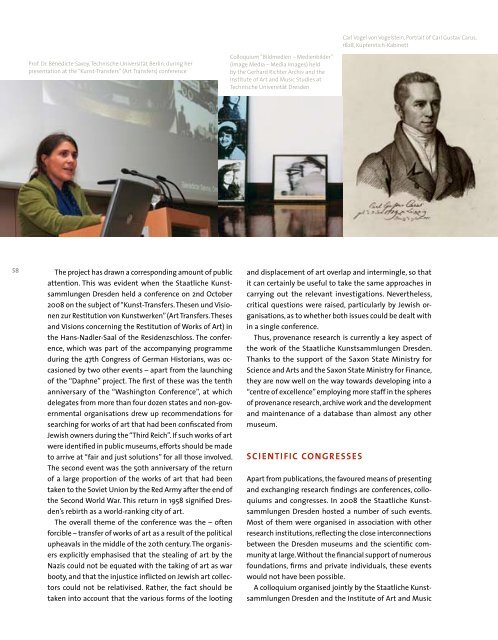2008 - Staatliche Kunstsammlungen Dresden
2008 - Staatliche Kunstsammlungen Dresden
2008 - Staatliche Kunstsammlungen Dresden
Create successful ePaper yourself
Turn your PDF publications into a flip-book with our unique Google optimized e-Paper software.
Prof. Dr. Bénédicte Savoy, Technische Universität Berlin, during her<br />
presentation at the “Kunst-Transfers” (Art Transfers) conference<br />
58 The project has drawn a corresponding amount of public<br />
attention. This was evident when the <strong>Staatliche</strong> <strong>Kunstsammlungen</strong><br />
<strong>Dresden</strong> held a conference on 2nd October<br />
<strong>2008</strong> on the subject of “Kunst-Transfers. Thesen und Visionen<br />
zur Restitution von Kunstwerken” (Art Transfers. Theses<br />
and Visions concerning the Restitution of Works of Art) in<br />
the Hans-Nadler-Saal of the Residenzschloss. The conference,<br />
which was part of the accompanying programme<br />
during the 47th Congress of German Historians, was occasioned<br />
by two other events – apart from the launching<br />
of the “Daphne” project. The first of these was the tenth<br />
anniversary of the “Washington Conference”, at which<br />
delegates from more than four dozen states and non-governmental<br />
organisations drew up recommendations for<br />
searching for works of art that had been confiscated from<br />
Jewish owners during the “Third Reich”. If such works of art<br />
were identified in public museums, efforts should be made<br />
to arrive at “fair and just solutions” for all those involved.<br />
The second event was the 50th anniversary of the return<br />
of a large proportion of the works of art that had been<br />
taken to the Soviet Union by the Red Army after the end of<br />
the Second World War. This return in 1958 signified <strong>Dresden</strong>’s<br />
rebirth as a world-ranking city of art.<br />
The overall theme of the conference was the – often<br />
forcible – transfer of works of art as a result of the political<br />
upheavals in the middle of the 20th century. The organisers<br />
explicitly emphasised that the stealing of art by the<br />
Nazis could not be equated with the taking of art as war<br />
booty, and that the injustice inflicted on Jewish art collectors<br />
could not be relativised. Rather, the fact should be<br />
taken into account that the various forms of the looting<br />
Colloquium “Bildmedien – Medienbilder”<br />
(Image Media – Media Images) held<br />
by the Gerhard Richter Archiv and the<br />
Institute of Art and Music Studies at<br />
Technische Universität <strong>Dresden</strong><br />
and displacement of art overlap and intermingle, so that<br />
it can certainly be useful to take the same approaches in<br />
carrying out the relevant investigations. Nevertheless,<br />
critical questions were raised, particularly by Jewish organisations,<br />
as to whether both issues could be dealt with<br />
in a single conference.<br />
Thus, provenance research is currently a key aspect of<br />
the work of the <strong>Staatliche</strong> <strong>Kunstsammlungen</strong> <strong>Dresden</strong>.<br />
Thanks to the support of the Saxon State Ministry for<br />
Science and Arts and the Saxon State Ministry for Finance,<br />
they are now well on the way towards developing into a<br />
“centre of excellence” employing more staff in the spheres<br />
of provenance research, archive work and the development<br />
and maintenance of a database than almost any other<br />
museum.<br />
sCiENTiFiC CONgREssEs<br />
Carl Vogel von Vogelstein, Portrait of Carl Gustav Carus,<br />
1828, Kupferstich-Kabinett<br />
Apart from publications, the favoured means of presenting<br />
and exchanging research findings are conferences, colloquiums<br />
and congresses. In <strong>2008</strong> the <strong>Staatliche</strong> <strong>Kunstsammlungen</strong><br />
<strong>Dresden</strong> hosted a number of such events.<br />
Most of them were organised in association with other<br />
research institutions, reflecting the close interconnections<br />
between the <strong>Dresden</strong> museums and the scientific community<br />
at large. Without the financial support of numerous<br />
foundations, firms and private individuals, these events<br />
would not have been possible.<br />
A colloquium organised jointly by the <strong>Staatliche</strong> <strong>Kunstsammlungen</strong><br />
<strong>Dresden</strong> and the Institute of Art and Music

















